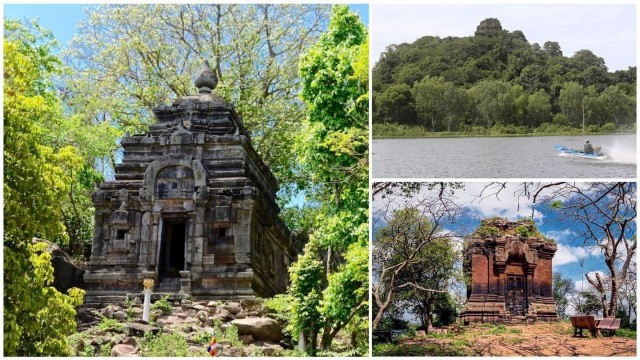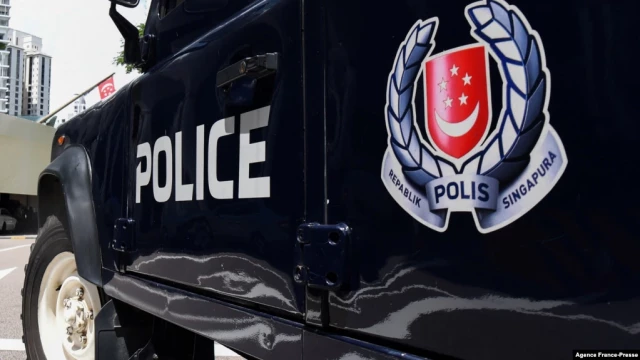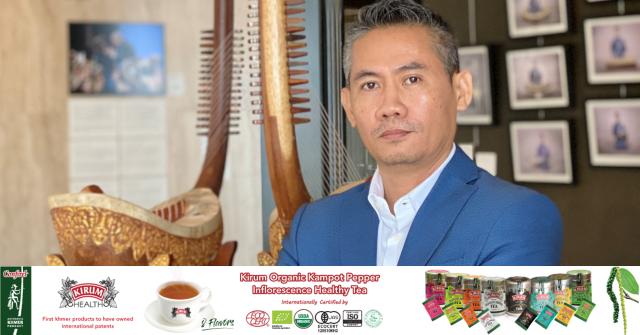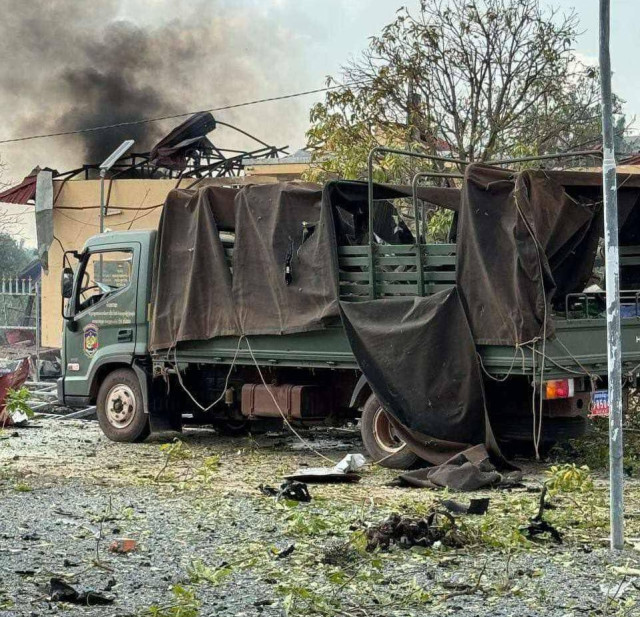Protecting Angkor 120 Years Ago: What Led to Cambodia’s Heritage to Be under Legal Shield
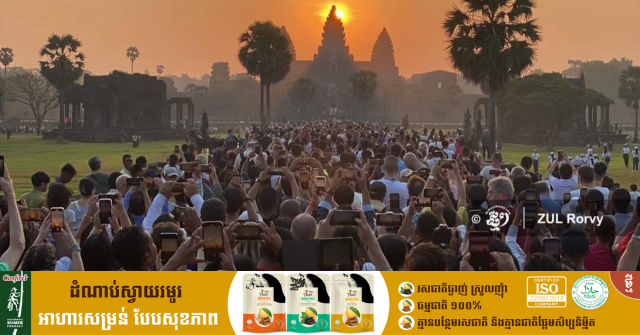
- By Michelle Vachon
- October 16, 2023 5:03 PM
PHNOM PENH — From the early 1870s through the mid-1890s, some French explorers would bring to Cambodia copies of famed Western artworks to exchange for Angkorian artworks, said Melanie McDonald.
In April 1890, when a French official assigned to Cambodia had asked King Norodom if he could take a sculpture that was in a nearby temple, the king had told him he would turn a blind eye if no one complained.
This was the early years. With the creation of the research institution Ecole francaise d’Extreme-Orient (EFEO) and the EFEO starting monument restoration at Angkor, regulations would soon be put in place to protect Cambodia’s heritage.
A conference on the laws and regulations issued while the country was under French administration brought to light the institutions and circumstances that, in the early 1900s up to the 1930s, prevented the country’s Angkorian and pre-Angkorian heritage from being stolen outright, and ensured that sculptures and artifacts would be recorded and protected.
This does not mean that the occasional object was not taken or sold, said Melanie McDonald during a conference on the laws established to protect the country’s heritage during the French Protectorate—conference held online by the Center for Khmer Studies earlier this year.
Still, this in no way compared to the situation that came to light in recent years regarding the removal of artifacts and artworks in Africa by the French and other European countries. As the British publication New Statesman mentioned in an article in March 2023, it is believed that 180,000 pieces of African art are at Belgium’s Royal Museum, an outcome of that country’s rule over Congo until 1960. The British Museum in London and the Musée du Quai Branly in Paris may both have around 70,000 African works in their collections—https://www.newstatesman.com/quickfire/2023/03/emmanuel-macron-right-return-african-art-africa—which is why some African countries are now demanding the return of their antiquities.
As McDonald said during the conference, Cambodia was an exception in several ways. First legally, the country was not a colony or a territory conquered by France. In the 1850s, a Cambodian king with a sense of geopolitics by the name of King Duang had sought France’s protection, realizing that, without a major nation’s support, the country would be gobbled up by its powerful neighbors: Thailand (then called Siam) and Vietnam. However, it is only in 1863 that France would sign the Protectorate Treaty with Cambodia that by then was led by King Norodom.
While signing the treaty, Cambodia insisted on one territorial matter, which would take France several decades to act on. At the express insistence of King Sisowath, the French authorities in 1907 would negotiate with Thailand the return of the provinces of Battambang, Siem Reap, which meant Angkor, and Sisophon (now Banteay Meanchey), McDonald said.
Finding information regarding the legislation on antiquities in Indochina and Cambodia and how it was implemented proved difficult, McDonald said. A PhD candidate in law at the Universite Paris II Assas, she holds master’s degrees in art history and international law from the Universite de Toulouse and the Sorbonne Paris IV universities in France.
Among the changes that the French would attempt to introduce were land regulations since prior to the protectorate era, all land in the country belonged to the king although some regulations were in place in Siem Reap province as a result of having been part of Thailand for 100 years or so. As French anthropologist Anne Guillou explained, the king was considered the “master of the land and the water.” Those farming the land had to pay the king a tax and would lose the right to farm it if they stopped farming the land for more than three years, she said.
Series of laws and regulations would be introduced over the years to define protection zones around historical monuments and historical features at Angkor and throughout the country, McDonald said. French and Cambodian administrators would also have to determine whose responsibility it was to implement those regulations, which would prove no simple matter, she said.

In 1923, King Sisowath had issued a royal ordinance through which he delegated to the French general governor the right to classify monuments in the country’s domain, with the EFEO playing the institutional role. Were excluded the Royal palace, Wat Phnom, and a few other sites.
In May 1925, Angkor Park was created, and in December 1929, the land around monuments became protected, with authorization required to farm when these were agricultural zones.
Another issue that led to a series of regulations evolving over decades and often with grey areas, which caused disagreements among administrators, was the sale of historical sculptures and artifacts.
As McDonald explained, under the protectorate, legislations and programs were progressively put in place by the French authorities and experts in cooperation with the Royal Palace and the Cambodian authorities to protect the country’s cultural heritage.
The initiative included the EFEO researchers and archeologists who, from 1907 on, worked on the restoration of monuments at Angkor, conducted research and studied inscriptions to find out about the kings and builders of those monuments.
One of the dilemmas, McDonald said, was whether the occasional odd artifact could be sold to tourists, and who would decide which ones could be let go.
At first, the EFEO sent Angkorian and pre-Angkorian artworks to Saigon (today’s Ho Chi Minh City) in Vietnam to be safeguarded and displayed. Then, after the inauguration of the National Museum in Phnom Penh—built after World War I in Europe and inaugurated in 1920—they were sent to that museum to be put on display. The EFEO wanted those works to be shown in the country in which they belonged, McDonald said.
The laws and regulations issued to protect Khmer artifacts from being stolen did not mean this did not happen, but the authorities hoped they served as a deterrent, McDonald said.
One event that drew attention to the illegal trade of Khmer artifacts was the case of Andre Malraux in 1923.
Then 22 years old, Malraux, who would become one of France’s foremost writers and the country’s minister of culture in the 1960s, was arrested for stealing statues from the temple of Banteay Srei in Siem Reap province. Malraux who had lost all his wife’s money on the stock exchange, had come up with the idea of stealing Khmer antiquities, taking them back to Europe and selling them there as a way to recover financially. The French administration’s Phnom Penh tribunal found him guilty and sentenced him to three years in jail. But the appeal court in Saigon reduced this to a one-year suspended sentence.
A decree in 1924 and more specific legislations would be put in place to eliminate loopholes regarding segments, debris and sculptures such as the ones suggested during the trial.
A few years earlier, the concept of “archeological debris” had provoked a debate, McDonald said. In 1919, some people had defended the idea of selling fragments of objects to raise funds and prevent tourists from packing the occasional “souvenirs” they had found at Angkorian or pre-Angkorian temples, she said. But the EFEO researchers were opposed to the idea, she added. In fact, in recent years, there have been several examples of Khmer-sculpture fragments being assembled, making the works whole such as the head of the sculpture of Harihara, which was in the Musée Guimet’s collection in Paris since 1889 being reattached in 2016 to the decapitated body of Harihara acquired in 1944 by the National Museum of Cambodia — www.theartnewspaper.com/2016/01/20/french-museum-reunites-head-with-decapitated-khmer-statue .
Still, in 1923 a list of objects that could be sold started being issued each year with prices and certificates of origin, the money going to the EFEO as a restoration fund for the temples, McDonald said. Each item had to be approved by the EFEO director and the director of the National Museum. To make this a triple validation process, reports on the objects sold were also submitted to the resident superior—the French public servant overseeing Cambodia in Indochina—she said.
Aware that visitors might leave with the occasional fragment they found at Angkor, the authorities had set up an onsite procedure. Visitors were asked to bring what they found to the authorities for the director of the EFEO to examine and determine whether they could keep it, McDonald said. But then, the director would not always be on hand, which did not make this a foolproof process, she said.

A decree issued in 1931 allowed the EFEO to sell “archeological debris,” which by then meant antiquities of lesser value, at the bungalow hotel located in Angkor Park, at hotels in Siem Reap City and in Saigon in Vietnam, McDonald said.
Four Cambodian antiquities would end up being sold to a museum in Amsterdam in the Netherlands in 1932, and six works to the Metropolitan Museum in New York City in 1936, she said. By then, she added, “[t]he French saw Angkor as a way to express their soft power in the world.”
Finding information regarding the legislation on antiquities in Indochina and Cambodia and how it was implemented proved difficult, McDonald said. The more so that the concept of objects of archeological value extended beyond Angkor and other archeological sites. According to a 1920 royal ordinance, a sculpture or artifact honored by the faithful in a pagoda had to remain in place and be under the supervision of the authorities, she said.
The challenges regarding those laws would also include whose responsibilities it was to make sure they were respected throughout the country, McDonald said. While the EFEO and the protectorate authorities may have focused on Angkor and the most prominent sites, less is known as to whether and how the other historical sites in the country were protected, she added.







